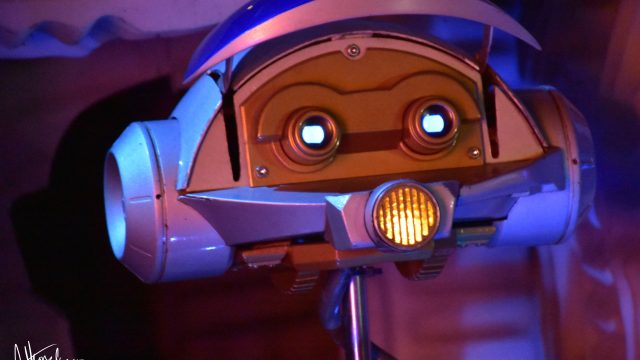It seems appropriate to start Year of the Month this month with Star Tours. It was, at least if you’re a Disney person, quite the moment. It was the first Disney attraction based on a non-Disney pre-existing intellectual property. This was the first time two of the biggest names in pop culture came together, unless you count Captain Eo (oh, we’ll be getting to Captain Eo), and it was the most advanced attraction in a Disney park. The technical aspects were new. It was also the first time the line area was fully developed to be anything other than a place to wait. Star Tours felt like a whole new era. It was so important to Disney that Disneyland literally stayed open sixty hours straight for the opening.
You the guest are winding your way through the Star Tours spaceport. A couple of familiar droids are working on a ship with mysterious carbon scoring. Other droids are doing mysterious things with mechanical bits. A large screen tells you about adventures you can have on exotic places like Tatooine and the Forest Moon of Endor. Eventually, you get to the front, where you tell the person how many are in your party and go line up to file into your seats. Sure, you’re tired and your feet hurt and you’ve heard the same announcement approximately fifty-seven times, but it’s still more interesting than just winding around and around outside Space Mountain, at least.
Then, you and thirty-nine of your closest friends file into a StarSpeeder 3000. The wall in the front slides down, and you meet your pilot, RX-24. Call him Rex. His voice actor will become extremely familiar, especially when he laughs. If you look closely, you will note that he has a tag on him with instructions to remove it before operation. He and his astromech droid, R2-D2, will today be taking you to the Forest Moon of Endor. They will not do this in the smoothest possible way, but you’ll get there eventually, and it’s amazing how much the Forest Moon of Endor looks like the Star Trader gift shop.
People who have been on the ride since 2011 will not quite recognize that description. However, this is what the ride was like when I, along with millions of others, rode it from 1987 to 2010. It reopened in 2011 in, in my opinion at least, an inferior fashion that we won’t be talking about much here. It’s nice that they improved it on a technical level, but frankly they leaned too hard into the prequels and lost a lot of the charm and honestly C-3PO was doing other things at the time the ride is now set and that’s always going to bother me.
So back to 1987. The ride system itself is called ATLAS—Advanced Technology Leisure Application Simulator. It was actually developed in Sussex based on military simulator technology. Disney Imagineering purchased the patent and developed it further. There were not a lot of similar rides at the time; it was definitely Disney’s first. The ride itself is, oversimplifying hugely, a giant box on hydraulics. The ride vehicle moves with the actions on the screen in front of you, which fools your mind into believing you’re moving more than you are. This is my full understanding of the engineering.
Rex was a delight. He was open about its being his first flight, and again, careful eyes would note that he was not fully operational yet. “I always wanted to do this” is a line that absolutely speaks to fans, because of course it’s what we were all thinking as well. He was in fact the second robot pilot voiced for Disney by Paul Reubens, which may come as a shock to people but remains true. The character was funny, but not in a particularly over-the-top way. I still remember my mom laughing every time we went on the ride together and particularly the first time.
Star Tours was a link to what Disney parks do best—take you into worlds in a fully immersive way. It was tricking your eyes and tricking your mind to make you think that you were moving more than you were. It was also the only way ‘80s technology could give you an immersive Star Wars experience. There was no other way to make a successful Star Wars ride in the Disney parks in those years; usual dark ride technology just wasn’t up to it.
The problem, I think, is that Disney learned some of the wrong lessons from the experience. Here’s the truth—the screen works great for Star Tours. Possibly it works great at some of the Galaxy’s Edge stuff; for obvious reasons, we haven’t been yet. But what made Star Tours work wasn’t just the technology. It wasn’t just the “I understood that reference” stuff, either. Rex was new to us, and we loved him. We went inside a world we already loved, true, but it wasn’t just “hey, you already know this!” It was “how would someone familiar with it but inexperienced in it react to these moments?”
Disney has in years since become too reliant on the screens. Too reliant in “I understood that reference.” At its beginning, while there was a lot of spectacle to Star Tours, Star Tours wasn’t about the spectacle. It was about the fun. It was about doing what you’d always wanted to do in a world you’d loved for years. Maybe Star Tours isn’t actually the single most significant pop culture development of 1987. But ye Gods it’s close.
Thanks as always to our own Anthony Pizzo, my go-to source for Disney park imagery. Help fund my family’s trip to check out Galaxy’s Edge by supporting my Patreon or Ko-fi!

